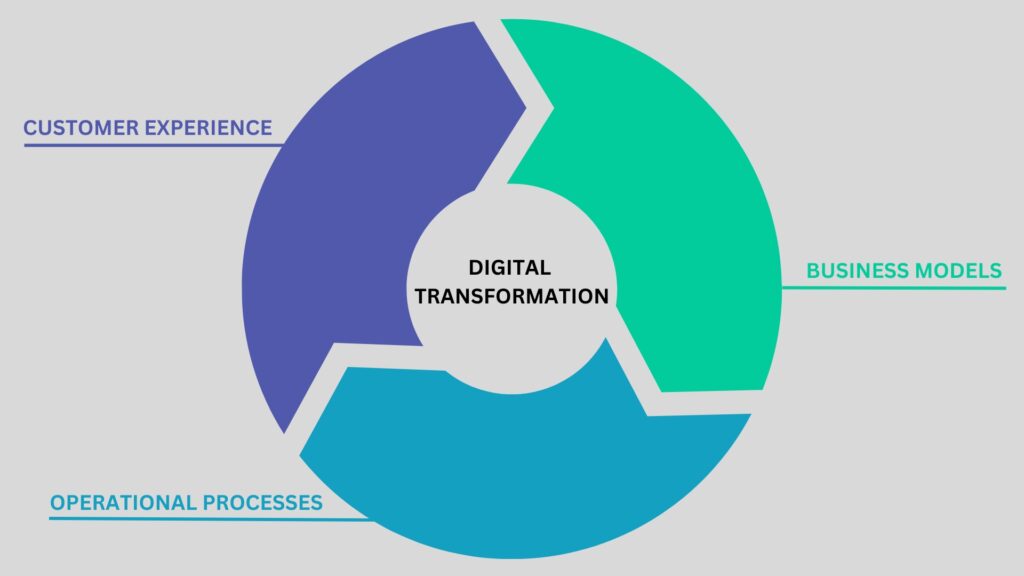Get a Call back
Technoforte takes enterprises on a journey of digital transformation – we restructure operational procedures to implement automated systems, streamline processes, and foster innovation.
Digital transformation refers to the process in which businesses integrate technology throughout their operations, setting in motion significant and fundamental changes. The aim of digital transformation services is to bring about heightened efficiency and increased business flexibility, so that fresh value can be created for employees, customers, and shareholders. Digital transformation examples are cloud migration, AI-powered chatbots, agile transitions and software enhancements.
It’s important to note that this path varies for each organization. One company may opt to improve the customer experience by leveraging AI or cloud computing, while another might decide to revamp its supply chain to make better use of machine learning. The right digital transformation services provider can walk you through what you need based on your business objectives.
For most companies, digital business transformation represents a departure from conventional thinking, giving way to a more collaborative and experimental approach. These innovative approaches with digital transformation services often unveil novel solutions and drive company growth from a fundamental level.

Our Digital Transformation Services

Cloud Migration
Our cloud migration solutions can enhance the flexibility of your business environment, broadening its horizons for scalability and connectivity. Enterprise application development is Technoforte’s area of expertise, which means you can expedite project timelines while migrating your mobile strategy to the cloud and consolidate network security with our digital transformation services.

Big Data Analytics
Consistently enhance business intelligence with an established, scalable approach to data analysis. Technofortes digital transformation services help you create user-friendly visualizations to comprehend customer preferences and market trends.

Artificial Intelligence & Machine Learning
Our digital transformation services address your challenges in business transformation by utilizing their expertise in Natural Language Processing, Machine Learning, intelligent automation, and predictive analytics, so that you can transition smoothly and without down time, while achieving the desired improvements in organizational processes.

Digital Applications
Future-proof your business! We swiftly develop greenfield applications with our digital transformation consulting team, and also help revamp systems and modernize legacy applications. The adoption of a microservices architecture with serverless workloads in the application we build means that you can reduce operational costs.

Digital Transformation Consulting
Digital Business transformation can be a bumpy road. Our digital transformation consultancy collaborates with you to formulate an effective strategy, equipped with our industry knowledge, insights into the customer journey, and an understanding of market dynamics.

Digital Transformation Strategy & Implementation
We empower organizations to innovate and deliver more efficiently than ever, leveraging market disruptions to gain a competitive edge as part of our digital transformation solutions. Our technical proficiency combined with years of experience ensures a seamless transition, whether it involves integrating AI into your business, modernizing IT infrastructure, or facilitating digitally-enabled applications.
The Digital Transformation Process
The efficacy of the digital transformation process to deliver the desired improvements depends entirely on how comprehensive the strategy is behind it. Technoforte’s digital transformation services apply a tried and tested digital transformation roadmap – a structured process – to accelerate your digital transformation initiatives via deep domain expertise.

What are the top 10 barriers to digital transformation?
From the Deloitte Global Survey of C-Suite Executives.
Digital transformation service providers can help you navigate these barriers, and guide through the various levels of digital transformation services and solutions.

Why are more and more businesses going for digital transformation services?
According to a report by Accenture, the pace of technology adoption through digital transformation services has significantly quickened in recent years. This acceleration can be attributed to swift advancements in technology and shifting consumer preferences, which are compelling businesses to become more flexible and attuned to digital trends. As a result, digitalization is reshaping the fundamental structures and procedures of enterprises, orienting them toward a more customer-centric approach.

Industry leaders tend to embrace innovative technologies earlier and allocate their resources to ongoing reinvestment. They exhibit a knack for making shrewd decisions regarding tech investments and allocate a significant portion of their IT budget to foster innovation.
When the COVID-19 pandemic hit, these industry leaders escalated their investments in pivotal technologies like cloud computing and artificial intelligence. This proactive approach allowed them to swiftly adapt to disruptions and redirect their efforts towards growth initiatives.
In stark contrast, many companies categorized as ‘laggards’ in their respective industries adopted newer technologies only when they had to, just to stay operational.
What sets the leaders apart is their focus on achieving innovative outcomes that transcend conventional economic metrics. They prioritize delivering exceptional user experiences, through digital transformation services, to effectively engage both their employees and customers. The leaders viewed the widespread shift to virtual business operations during the pandemic as an opportunity to create novel, meaningful digital experiences.
Examples of Digital Transformation Services and Solutions
Digital transformation occurs across all job functions and industries. Here, we enumerate real-world digital transformation examples that can help you understand what digital transformation service providers can do for you.
Examples of Digital Transformation Services by Job Function
| Job Function | Digital Transformation | Real-World Examples |
| Marketing | Personalized marketing automation – implementing AI-driven tools for customer segmentation, personalized delivery, and targeted advertising | Coca-Cola leveraged digital transformation by utilizing AI-powered marketing platforms to analyze consumer behavior and tailor marketing campaigns accordingly. |
| HR | Utilizing cloud-based platforms for recruitment, onboarding, training, and performance management. | Unilever implemented Workday’s cloud-based HR system to streamline their HR processes across their global workforce. |
| Finance | Implementing blockchain technology for secure and transparent financial transactions, such as payments and settlements | J.P. Morgan Chase has developed their own blockchain-based platform called Quorum for interbank payments and trade finance. |
| Customer Service | Deploying AI chatbots for handling customer inquiries, providing 24/7 support, and automating responses. | Sephora uses chatbots to assist customers with product recommendations, makeup tutorials, and order tracking. |
Examples of Digital Transformation by Industry
Industry | Digital Transformation | Real-World Examples |
Manufacturing | Incorporating IoT sensors, big data analytics, and automation to enhance production efficiency and product quality | Siemens implemented a comprehensive digital transformation strategy, leveraging IoT and AI to optimize manufacturing processes in their factories. |
Healthcare | Integrating telehealth platforms and wearable devices for remote consultations and continuous health monitoring. | The Cleveland Clinic expanded its telemedicine services during the COVID-19 pandemic to provide remote consultations and follow-ups for patients. |
Retail | Omni-channel retailing – Integrating online and offline channels to provide a seamless shopping experience for customers, including options like click-and-collect, in-store pickups, and same-day delivery. | Walmart has implemented digital transformation initiatives to enhance omni-channel capabilities and compete with e-commerce giants like Amazon. |
Education | Implementing e-learning platforms and digital classrooms for remote learning, online courses, and virtual collaboration among students and educators. | Khan Academy offers a wide range of free educational resources and interactive lessons accessible to learners worldwide.
|

Why Technoforte’s Digital Transformation Consultancy Services?
We are a company specializing in digital transformation services, dedicated to assisting businesses in achieving tangible outcomes and establishing agile procedures. We offer tailored digital transformation services after evaluating their current capabilities. Our digital transformation services encompass the following:
Comprehensive Strategy
Our approach involves refining digital transformation strategies that are cost-effective and customer-centric. These strategies for digital transformation services enable businesses to creatively acquire, retain, and support customers using cutting-edge technologies that continually enhance their capabilities.
Reduced Costs for R&D
We assist IT leaders worldwide in shifting their focus beyond cost efficiency to fuel growth and enhance value. We encourage clients to view digital business transformation as an efficient process that empowers organizations to execute end-to-end transformations rapidly and at scale.
Change Management
We help organizations smoothly navigate the digital transformation framework by ensuring that there is an understanding of how the change will impact processes, systems and employees. When changes are eased in through procedures of planning and testing, communicating change, scheduling, implementing and documenting it, the organization is able to adapt easier.
Improved Processes
Implementing advanced digital transformation services empowers forward-thinking businesses to become more responsive and adaptable to market trends and demands.
Speak to our in-house experts today to learn more about digital transformation services in India!
Digital Transformation FAQs
What is the definition of digital transformation?
Digital transformation can be defined as the use of various digital technologies to evolve materially or create novel business processes.
What are the pillars of digital transformation?
The foundation of digital transformation lies in the fact that it is not only about the technology, it is about “tech-enabled change.” In order to gain a perspective beyond the technology aspect, it is important to understand the pillars of digital transformation:
● Experiences involve both customer and employee interactions. Successful digital transformations result in positive experiences for those affected. Consider whether the initiative enhances customer connections and improves employee efficiency.
● The role of people is pivotal; culture drives and inhibits digital transformation. Neglecting the impact on individuals can hinder progress. Empower the people aspect by appointing change leaders who actively support and expedite the transformation. The aim is to devise initiatives that utilize technology to enhance human experiences.
● Change is indispensable for transformation. Drawing from established change management models and effective communication practices facilitates addressing the change aspect. It entails articulating transformation expectations, setting clear goals, and garnering support from those impacted.
● Innovation is a catalyst for transformative creativity. Fostering collaboration and embracing novel ideas are central to the innovation aspect. It bolsters digital transformation by prompting organizations to seek inventive solutions to challenges.
● Leadership is fundamental; without proactive guidance, initiatives falter. Leaders must oversee not only the implementation but also the outcomes of digital transformation efforts. Establishing key performance indicators (KPIs) and steering teams towards success falls under leadership’s purview.
● Culture is integral to digital transformation. Prioritizing people over technology fosters a conducive business environment. Start with enhancing employee and customer experiences before delving into technological advancements.
What is the cost of digital transformation?
It can be quite expensive to initiate digital transformation. However, when implemented properly, it results in massive cost savings over time. Depending on the scale of the digital transformation initiative, the cost can fluctuate. It is predicted that organizations may spend up to $2.3 trillion on digital transformation by 2023.
What are the technologies driving digital transformation?
There are few technologies that are most commonly used by businesses trying to drive digital transformation:
● AI and machine learning (ML)
● Blockchain
● Cloud computing
● Virtual reality/augmented reality (VR/AR)
● Smartphones and applications
● Digital twins
● Blockchain
● Internet of Things (IoT)
What are the benefits of digital transformation?
There are numerous benefits to digital transformation in terms of improved business processes and greater overall efficiency. Some of these are:
● Better collection of data
● Improvements in quality control
● Significant cost savings
● Enhanced resource management
● An improved business model
● Enhanced customer experience
What is a digital transformation framework?
Digital transformation can make significant alterations in the status quo. Change management therefore becomes essential, and a digital transformation framework can help you manage this change. This framework can be designed using references from established change management models. An example of this is the McKinsey 7-S model. This model is based on the idea that there should be balance between the seven basic elements of change: shared values, structure, skills, style, strategy, systems and staff.
Digital transformation involves several moving parts – the people, technology and training etc. The balance becomes critical to the success of the implementation. If the focus is on the tool, you may end up neglecting a need for training.
What are the 3 key areas of enterprise digital transformation?
From the MIT Sloan Management Review, enterprise digital transformation covers 3 key areas:
● Business Models: Changing organizations by augmenting physical products and services with technology
● Operational Processes: Improving internal processes by leveraging automation and digitization, promoting employees with digital tools, using data to improve performance and drive strategic business decisions
● Customer Experience: Understanding customers in greater detail, fueling growth with technology, and creating a higher number of customer touchpoints.

3rd Floor, VRR Royal Commercial Complex, (Above Pratham Motors – Maruti Suzuki Car showroom), No.90/85/2, 17th Cross, 21st A Main Road, Sector-I, HSR Layout, Bengaluru, Karnataka, 560 102, India.
© Copyright 2024. Technoforte. All rights reserved